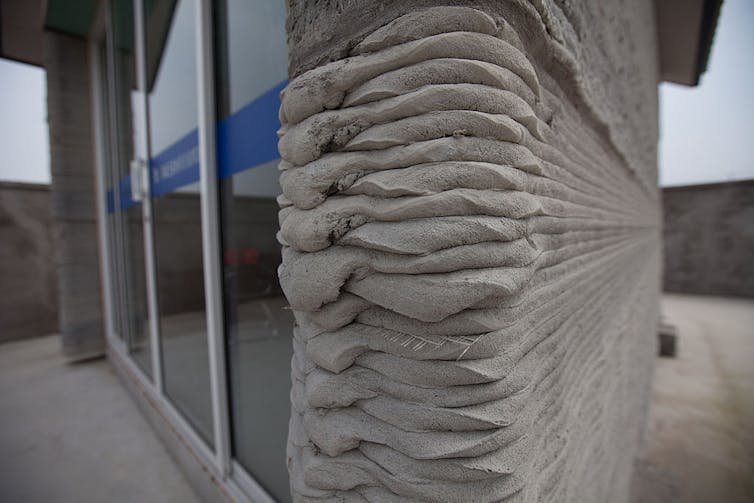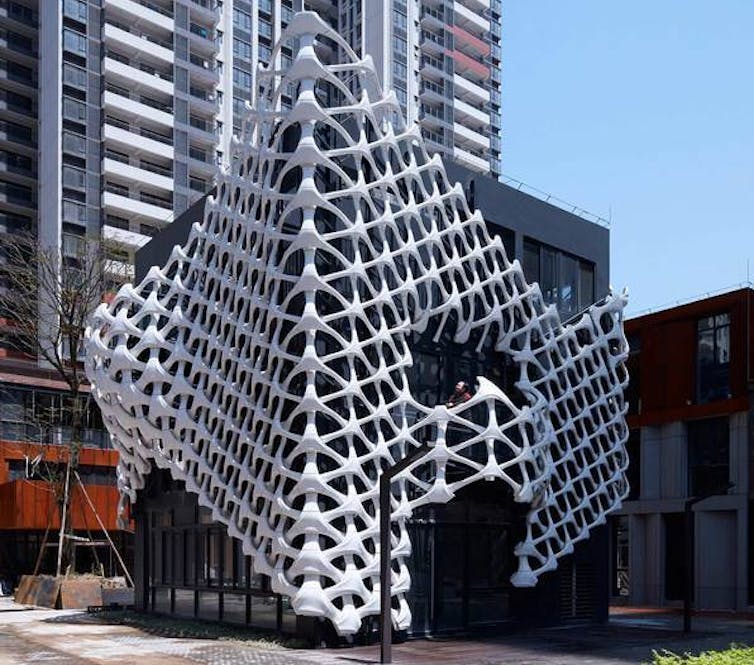3D printing promises to transform architecture forever – and create forms that blow today’s buildings out of the water
James Rose University of Tennessee – In architecture, new materials rarely emerge.
Concrete, masonry, and wood have been the mainstays of many structures throughout history.
The steel frame revolutionized architecture in the 1880s. Steel allowed architects to design taller buildings that had larger windows. The result was the skyscrapers we see today.
Construction materials have largely been limited to mass-produced components since the industrial revolution. This standardised set of parts has been the basis of building design for over 150 years, from steel beams to plywood panels.
That may soon change with advances in what’s called “large-scale additive manufacturing.” Not since the adoption of the steel frame has there been a development with as much potential to transform the way buildings are conceived and constructed.
Additive manufacturing at large scale, such as desktop 3D printing allows you to build objects layer by layer. Whether it’s clay, concrete or plastic, the print material is extruded in a fluid state and hardens into its final form.
As director of the Institute for Smart Structures at the University of Tennessee, I’ve been fortunate to work on a series of projects that deploy this new technology.
Although there are still some obstacles to widespread adoption of this technology, I see a future where buildings will be built entirely out of recycled materials or materials sourced on site, using forms inspired by nature’s geometries.
Promising prototypes
The Trillium Pavilion is one of these structures. It is an open-air structure made from recycled ABS polymer. This plastic is widely used in a variety of consumer products.
The structure’s thin, double-curved surfaces were inspired by the petals of its namesake flower. The students designed and printed the project at Loci Robotics. It was then constructed at Cherokee Farm, University of Tennessee in Knoxville.
Another example of large-scale additive production is Tecla. This prototype dwelling measuring 450 square feet (41.8 m2) was designed by Mario Cucinella Architectures. It was printed in Massa Lombarda (a small Italian town).

Tecla was printed by the architects using clay from a nearby river. This unique combination of cheap material and radial geometry resulted in an energy-efficient alternative housing.
Back in the U.S., the architecture firm Lake Flato partnered with the construction technology firm ICON to print concrete exterior walls for a home dubbed “House Zero” in Austin, Texas.
This home measures 2,000 square feet (185.8 meters) and demonstrates 3D-printed concrete’s speed and efficiency. The structure also displays a striking contrast between its curvilinear walls, and its exposed timber frame.
Planning
Three knowledge areas are required for large-scale additive manufacturing: digital design, digital fabrication, and material science.
To start, architects create computer models for all the parts that will be printed. The software can be used by these designers to determine how the components will react to structural forces, and to adjust the components accordingly. These tools can be used to help designers reduce weight and automate design processes such as smoothing complicated geometric intersections before printing.
Slicer software is a piece of software that converts the computer model to a set instructions for the printer.
You might assume 3D printers work at a relatively small scale – think cellphone cases and toothbrush holders.
3D printing technology has allowed hardware to scale up significantly. Sometimes the printing is done via what’s called a gantry-based system – a rectangular framework of sliding rails similar to a desktop 3D printer. Because they can print in any orientation, robotic arms are increasingly being used.
The location of printing can also differ. While smaller parts and furnishings can be printed in factories for printing, entire houses must be printed on site.
For large-scale additive production, a wide range of materials are possible. Concrete is a very popular material due to its reliability and familiarity. Clay is an intriguing alternative because it can be harvested on-site – which is what the designers of Tecla did.
Polymers and plastics could be the most versatile. These materials can be made in a variety of ways to meet specific aesthetic and structural requirements. They can also come from organically and/or recycled materials.
Inspiration comes from the natural world
Because additive manufacturing builds layer by layer, using only the material and energy required to make a particular component, it’s a far more efficient building process than “subtractive methods,” which involve cutting away excess material – think milling a wood beam out of a tree.
Even common materials like concrete and plastics benefit from being 3D-printed, since there’s no need for additional formwork or molds.
Today’s construction materials are mass-produced using assembly lines that are specifically designed to produce identical components. This reduces costs, but leaves little opportunity for customization.
Large-scale additive production is possible without the use of tools, forms, and dies. Each part can be made unique with no extra cost or time penalty.
Large-scale additive manufacturing also offers the possibility to create complex components with internal gaps. This could allow walls to be printed with conduit and ductwork already in position.
In addition, research is taking place to explore the possibilities of multi-material 3D printing, a technique that could allow windows, insulation, structural reinforcement – even wiring – to be fully integrated into a single printed component.
I find it fascinating that additive manufacturing, which is essentially building layers with a slow hardening material, mimics natural processes like shell formation.

This opens up new possibilities for designers, who can implement geometries difficult to create using other construction methods. However, they are very common in nature.
A lightweight lattice of tubes could be made using structural frames inspired by bird bone’s fine structure. Façades that evoke the shapes of plant leaves might be designed to simultaneously shade the building and produce solar power.
Learning curve
Despite all the positive aspects of large scale additive manufacturing, there are still many barriers to wider adoption.
The biggest challenge is its novelty. It is a complex infrastructure that revolves around traditional methods of construction such as steel, concrete, and wood. These include supply chains, building codes, and even building codes. The cost of digital fabrication hardware can be quite expensive, and it is not easy to learn the design skills required to work with these materials.
3D printing architecture needs to find its niche in order to be more widely accepted. It will take a special application of large-scale additive production to make it popular, much like word processing did for desktop computers.
Its ability to produce highly efficient structural frames may be what it is. I also already see its promise for creating unique sculptural façades that can be recycled and reprinted at the end of their useful life.
It seems probable that a combination of factors will make it possible for future buildings to be 3D-printed in some way.

James Rose, Director at the Institute for Smart Structures University of Tennessee
This article is republished under Creative Commons licence from The Conversation. The original article is available here.